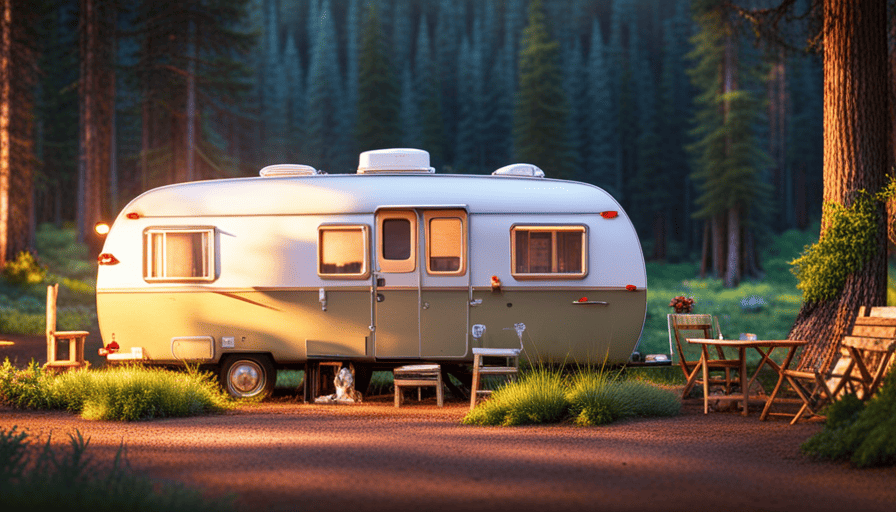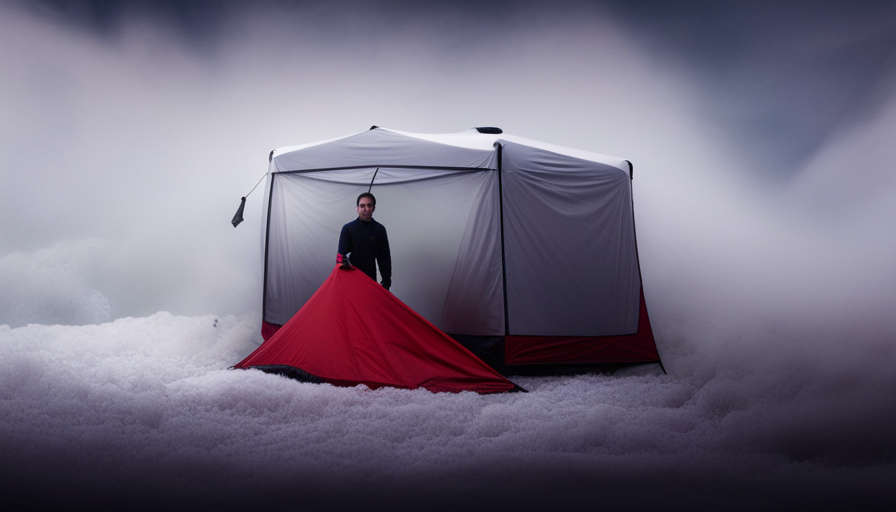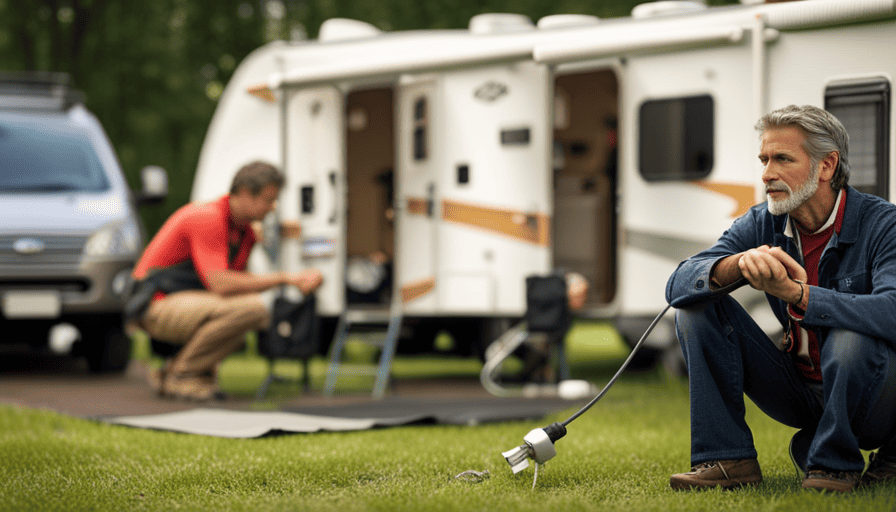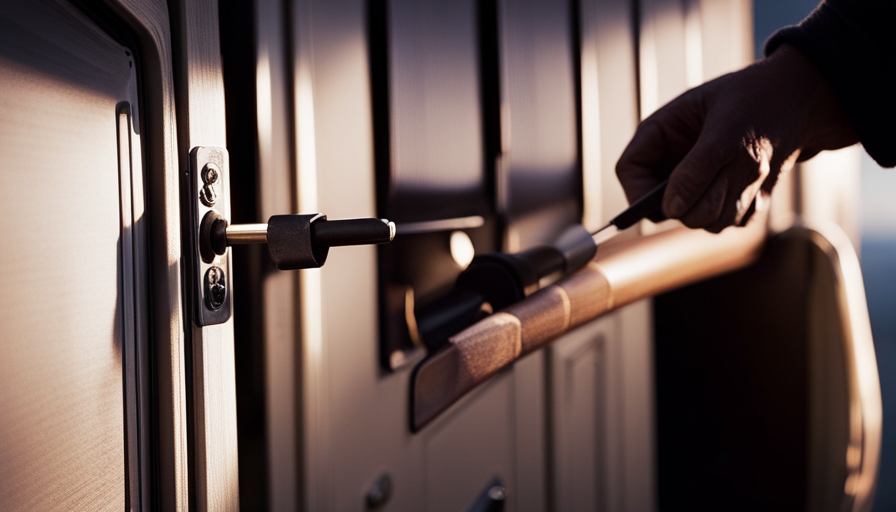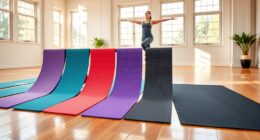The saying goes, ‘The world is your oyster,’ and when it comes to outdoor adventuring, a teardrop camper stands out as the perfect jewel.
These compact and cozy trailers offer a unique blend of convenience and wanderlust, allowing you to embark on epic adventures without sacrificing comfort. From rugged mountains to serene lakeshores, the possibilities are endless with a teardrop camper by your side.
But how much does this dream on wheels cost? Well, my fellow adventurers, the price of a teardrop camper can vary depending on several factors. From the type of camper and its size to the quality of materials and additional features, there are plenty of variables to consider.
Whether you’re looking for a budget-friendly option or a top-of-the-line model, I’m here to guide you through the pricing maze and help you find the best deal.
So, buckle up and get ready to dive into the world of teardrop campers, where freedom and exploration await. Let’s embark on this thrilling journey together and uncover the secrets of how much a teardrop camper truly costs.
Key Takeaways
- The price of a teardrop camper can vary based on factors such as type, size, and features.
- Different brands have varying reputations and customer reviews, so it’s important to consider this when choosing a camper.
- Options for customization, such as awnings, AC, and solar panels, allow for personalization and enhanced camping experiences.
- Rental options are available for those who want to test out different models before making a purchase.
Types of Teardrop Campers
So, if you’re in the market for a teardrop camper, let me tell you about the different types that are available! Teardrop campers are known for their compact size and cozy interiors. What makes them even more appealing is the ability to customize them to fit your specific needs.
Whether you’re a minimalist traveler or someone who wants all the comforts of home, there’s a teardrop camper out there for you.
One option is to buy a pre-made teardrop camper that comes with all the essentials. These campers often have a small kitchenette, a sleeping area, and storage space. However, if you prefer to have more control over the design and layout, you can opt for a DIY teardrop camper kit. This allows you to customize the camper to your heart’s content, adding features like solar panels, a portable toilet, or even a mini-fridge.
If you’re not ready to commit to buying a teardrop camper just yet, there are also rental options available. This is a great way to test out different models and see which one suits your needs before making a purchase. Many rental companies offer a variety of teardrop campers to choose from, so you can try them out and see which one you like best.
Now, let’s move on to the exciting world of teardrop camper size and layout options!
Size and Layout Options
Choose the perfect size and layout for your teardrop camper, and you’ll have a cozy and functional travel companion.
Teardrop campers come in a variety of sizes, ranging from compact models that can accommodate two people to larger ones that have enough space for a small family. The size you choose depends on your needs and preferences. If you’re a solo traveler or a couple looking for a compact and lightweight option, a smaller teardrop camper might be the best fit. On the other hand, if you have a larger group or need more storage space, a bigger teardrop camper will be more suitable.
When it comes to layouts, teardrop campers offer a range of options to suit different lifestyles. The most common layout is the classic cabin style, where the sleeping area is located at the rear of the camper and the kitchen is situated at the front. This layout maximizes space efficiency and provides a cozy sleeping area.
Another popular layout is the galley style, where the kitchen is located at the rear and the sleeping area is at the front. This layout is great for those who enjoy cooking and want easy access to their kitchen.
As you consider the size and layout options for your teardrop camper, keep in mind that the quality of materials and construction also play a crucial role in its durability and longevity.
Quality of Materials and Construction
When considering the perfect size and layout for your teardrop camper, it’s important to prioritize the quality of materials and construction to ensure durability and longevity. The cost of a teardrop camper can vary depending on the materials and construction methods used.
While some campers may be cheaper, they may also be made with lower quality materials that can deteriorate quickly over time. On the other hand, investing in a camper with high-quality materials and solid construction can provide greater durability and longevity.
Pros of choosing a teardrop camper with quality materials and construction include:
- Long-lasting: Well-built campers can withstand the test of time and provide years of enjoyment.
- Sturdy: High-quality materials and construction techniques ensure that the camper can withstand rough terrains and adverse weather conditions.
- Low maintenance: A well-constructed camper requires less maintenance and repairs, saving you time and money in the long run.
- Resale value: Campers with superior materials and construction tend to retain their value better, making them a good investment.
However, it’s important to consider the cons as well. Quality materials and construction often come with a higher price tag. Although it may require a larger upfront investment, the long-term benefits outweigh the initial cost.
Transitioning into the subsequent section about additional features and upgrades, it’s essential to explore the various options that can enhance your teardrop camper experience.
Additional Features and Upgrades
Enhancing your teardrop adventure is like adding the cherry on top, with a plethora of additional features and upgrades to take your camping experience to the next level. When it comes to customization options, teardrop campers offer endless possibilities. From exterior paint colors to interior layouts, you can truly make it your own. Want a cozy bed that converts into a dining area? Or maybe a compact kitchenette with a mini-fridge and a stove? The choice is yours.
But it doesn’t stop there. Interior design trends have made their way into the world of teardrop campers. You can choose from a wide range of stylish upholstery fabrics, trendy wallpaper patterns, and modern fixtures. Some manufacturers even offer solar panels for off-grid power and entertainment systems for those movie nights under the stars.
To help you visualize the possibilities, here’s a table showcasing some popular additional features and upgrades:
| Additional Features | Upgrades |
|---|---|
| Outdoor awning | Roof rack |
| Air conditioning | Bluetooth speakers |
| Portable toilet | LED lighting |
| Bike rack | External shower |
These enhancements not only make your camping experience more comfortable but also add a touch of luxury to your teardrop camper. Speaking of luxury, let’s dive into the world of different brands and manufacturers, where quality and reputation take center stage.
Brand and Manufacturer
Looking for the perfect brand and manufacturer to trust for your dream teardrop adventure? Look no further, because we’ve got all the information you need to make an informed decision.
When it comes to teardrop campers, the brand and manufacturer play a crucial role in determining the quality and reliability of the camper. It’s important to consider the brand reputation and customer reviews before making a purchase.
One popular brand known for its exceptional teardrop campers is [Brand Name]. With a strong reputation in the market, they’ve consistently delivered high-quality products that meet the needs of adventure enthusiasts. Their attention to detail and commitment to customer satisfaction have earned them rave reviews from customers all around.
Another reputable brand to consider is [Brand Name]. With their innovative designs and durable construction, they’ve become a favorite among teardrop camper enthusiasts. Customers appreciate their excellent craftsmanship and the level of comfort their campers provide.
When choosing a brand and manufacturer, it’s essential to consider your specific needs and preferences. Take the time to read customer reviews and research different brands to find the one that aligns with your vision of the perfect teardrop camper.
Ready to explore the next section about ‘new vs. used teardrop campers’? Let’s dive in and discover the pros and cons of each option.
New vs. Used Teardrop Campers
If you’re torn between the allure of a brand new adventure and the cost-saving benefits of a pre-loved journey, let’s weigh the pros and cons of new vs. used teardrop campers.
When it comes to buying a teardrop camper, there are advantages and disadvantages to both options.
Starting with new teardrop campers, one of the biggest pros is that you get to be the first one to experience the excitement and joy of owning it. Everything is shiny and pristine, and you can customize it to your liking. Additionally, new campers often come with warranties, giving you peace of mind in case anything goes wrong. However, the downside is that new campers can be quite expensive. You’ll have to be prepared to pay a higher price for the latest features and technology.
On the other hand, used teardrop campers offer a more budget-friendly option. You can find great deals on pre-owned campers that still have plenty of life left in them. It’s a chance to own a teardrop camper without breaking the bank. However, there may be some wear and tear, and you won’t have the same level of customization options as with a new camper. It’s important to thoroughly inspect a used camper before making a purchase to ensure it’s in good condition.
The decision between a new or used teardrop camper ultimately depends on your priorities and budget. Consider the pros and cons of each option before making your choice. Now, let’s dive into the next section about financing and insurance options.
Financing and Insurance Options
Financing and insurance options can provide peace of mind when purchasing a camper, ensuring that you’re protected financially in case of any unforeseen events. For example, imagine finally finding your dream adventure vehicle and being able to secure a loan that fits within your budget, allowing you to hit the road and explore the great outdoors without worrying about the upfront cost.
When it comes to financing options, there are several routes you can take. You can choose to finance through a dealership or a bank, and they can help you find a loan with terms that suit your needs. Some dealerships even offer in-house financing, making the process even more convenient. Additionally, you may be able to find special financing programs specifically designed for campers, offering competitive interest rates and flexible repayment plans.
Insurance coverage is another important aspect to consider. You want to make sure your teardrop camper is protected against theft, accidents, and natural disasters. Insurance companies offer a range of coverage options, including comprehensive coverage, liability coverage, and roadside assistance. It’s important to carefully consider your insurance needs and find a policy that provides adequate protection for your camper.
Now that we’ve covered financing and insurance options, let’s move on to the next step: the cost comparison of different models.
Cost Comparison of Different Models
One important factor to consider is how the prices of various models compare to each other. When it comes to teardrop campers, there are plenty of options available that cater to different budgets. Whether you’re looking for a budget-friendly option or willing to splurge for a more luxurious model, there is something out there for everyone.
If you’re on a tight budget, there are affordable teardrop campers that offer all the basic amenities you need for a comfortable camping experience. These budget options typically have a simpler design and fewer features, but they still provide a cozy sleeping area and a small kitchenette. They may be more compact in size, but they can still provide you with a great camping experience without breaking the bank.
On the other hand, if you’re willing to spend a bit more, there are high-end teardrop campers available that offer added luxury and convenience. These models often come equipped with features such as air conditioning, entertainment systems, and even bathrooms. They provide a more spacious interior and are built with higher-quality materials, ensuring durability and longevity.
When comparing the costs of different models, it’s important to consider not just the initial price but also any additional costs such as maintenance and insurance. By carefully considering your budget and needs, you can find a teardrop camper that fits your lifestyle and ensures a memorable camping experience.
Speaking of budget options, another option to consider is building your own teardrop camper. This allows you to customize the design to your liking while potentially saving money. Stay tuned for the next section on DIY teardrop camper building to learn more about this exciting possibility.
DIY Teardrop Camper Building
Ready to create your own adventure on a shoestring budget? Dive into the world of DIY teardrop camper building and unlock the freedom to design your dream camping haven.
Building your own teardrop camper is not only a rewarding experience, but it also allows you to customize every aspect to suit your needs and style. With a little bit of planning and some essential tools, you can turn your vision into a reality.
To get started, you’ll need some DIY teardrop camper plans. These plans provide step-by-step instructions on how to construct your camper from scratch. They include detailed measurements, materials lists, and diagrams to guide you through the process. There are many websites and resources available online where you can find these plans for free or for a small fee.
Once you have your plans, you’ll need some essential tools for building a teardrop camper. These include a circular saw, drill, jigsaw, router, and sander. You’ll also need basic hand tools like screwdrivers, clamps, and measuring tape. Investing in good quality tools will make the building process easier and ensure a better end result.
With your plans and tools in hand, you can begin the exciting journey of building your own teardrop camper. Remember to take your time, follow the instructions carefully, and enjoy the process. Soon enough, you’ll be ready to hit the road and start your camping adventures in your very own DIY teardrop camper.
Looking for tips on finding the best deal for a teardrop camper? Stay tuned for the next section.
Tips for Finding the Best Deal
Looking to score the best deal for your dream adventure on a shoestring budget? Let’s dive into some helpful tips for finding the perfect teardrop camper.
When it comes to researching online, there are plenty of websites and forums dedicated to RV enthusiasts where you can find a wide range of teardrop campers available for sale. Take your time to browse through different listings, compare prices, and read reviews from previous buyers. This will give you a good idea of what to expect and help you narrow down your options.
Once you’ve found a teardrop camper that catches your eye, don’t be afraid to negotiate with the seller. Many sellers are open to offers and may be willing to lower the price or throw in some extra accessories. Be prepared to ask questions about the camper’s condition, any repairs or upgrades that have been done, and whether or not it comes with a warranty.
Remember, finding the best deal isn’t just about the price tag. Consider the overall value of the camper, including its size, features, and durability. By doing your research and negotiating with sellers, you can find the teardrop camper of your dreams without breaking the bank.
So get out there and start your adventure!
Frequently Asked Questions
Are teardrop campers suitable for long-term living or just for short camping trips?
Teardrop campers, with their compact design and efficient use of space, are perfect for both short camping trips and long-term living. While they may not provide the same level of luxury as larger RVs, teardrop campers offer numerous benefits for those seeking a nomadic lifestyle.
With features such as a cozy sleeping area, compact kitchenette, and storage space, these campers provide a comfortable and convenient living space on the road. Whether you’re embarking on a short adventure or a long-term journey, teardrop campers are the ideal companion.
How much does it cost to maintain a teardrop camper on a yearly basis?
The cost of maintaining a teardrop camper on a yearly basis depends on several factors. These include the age of the camper, the frequency of use, and the type of terrain you navigate.
Regular maintenance tasks like cleaning, inspecting the tires, and checking the electrical system are essential. Additionally, factors like repairs, fuel expenses, and insurance should also be considered.
Proper maintenance ensures that your teardrop camper remains in great shape, allowing you to embark on countless adventures without worry.
Can teardrop campers be customized to fit specific needs and preferences?
When it comes to personalizing teardrop campers, the options are endless. You can truly make it your own, from interior design to exterior features. Whether you want a cozy cabin-like feel or a sleek and modern look, customization options allow you to create a camper that suits your specific needs and preferences. It’s like turning a blank canvas into a masterpiece, adding unique touches that reflect your adventurous spirit. Let your imagination run wild and create the camper of your dreams.
Are teardrop campers suitable for off-road adventures and rugged terrains?
Teardrop campers are perfect for off-road adventures and rugged terrains due to their impressive off-road capabilities and durability.
These compact trailers are designed to withstand the challenges of rough terrains, providing a thrilling and adventurous experience.
With their sturdy construction and robust features, teardrop campers can handle the bumps, dips, and obstacles encountered on off-road journeys.
So, whether you’re exploring remote trails or conquering rocky landscapes, a teardrop camper is a reliable companion for your wild escapades.
What is the average lifespan of a teardrop camper?
Teardrop campers are built to last a lifetime and then some! With proper care, the average lifespan of a teardrop camper can reach astronomical lengths.
These compact wonders are designed to withstand the toughest terrains and weather conditions, making them perfect for adventurous souls like myself. Maintenance costs are surprisingly low, thanks to their durable construction. So, you can spend less time worrying about repairs and more time exploring the great outdoors!
What is the Price Range for Pop Up Campers?
The pop up camper price guide provides information on the price range for these portable camping trailers. Depending on various factors such as brand, size, and features, prices can vary significantly. Entry-level pop up campers can start around $5,000, while higher-end models can range upwards of $20,000 or more. It is essential to consult the pop up camper price guide to determine the best fit for your budget and camping needs.
Conclusion
As I stood there, gazing at the teardrop campers lined up before me, I couldn’t help but feel a sense of excitement. The different sizes and layouts offered endless possibilities for my next adventure.
The quality of materials and construction ensured durability and comfort, while the additional features and upgrades added a touch of luxury. With various brands and manufacturers to choose from, I knew I could find the perfect fit for my needs.
And with financing and insurance options available, owning a teardrop camper was within reach. As I embarked on my journey, I couldn’t wait to hit the open road and create unforgettable memories.


